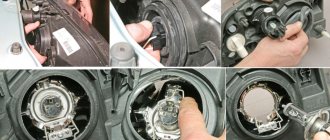Previously, we compared Vesta and its competitors (Kia Rio and Hyundai Solaris). Then it was clear that AVTOVAZ’s new product was a full-fledged player in the modern car market, capable of taking away a significant share of buyers from the leaders. In February, Solaris appeared in a new body, which in many ways was better than its predecessor. We decided to compare the Lada Vesta sedan and New Solaris.
Differences between Lada Vesta and Lada X-Ray
They consist in the fact that the Lada Vesta is a fundamentally new development of AvtoVAZ, and many are even tired of waiting for its appearance, because there have been conversations about it for at least several years, if not a whole decade. X Ray, what to hide, is just a deeply redesigned Renault Sandero Stepway, which itself is based on the familiar, indestructible Logan.
The development of the Lada Vesta sedan went long and hard.
What to choose - proven reliability over the years, albeit in a new shell, or innovation, so advertised by AvtoVAZ? Experience suggests that Russians are more inclined to trust proven solutions.
It was on the basis of the Renault Sandero Stepway that the Lada X-Ray was created.
THREE FROM THE CASTER
Editorial "Largus" tried on three pairs of gears with different gear ratios. In addition to the standard fifth gear of 0.892, we sequentially installed sets of 0.820 and 0.795 (see table). On a 300-kilometer test route, including highways and suburban roads, they compared the difference in fuel consumption and accumulated subjective assessments, which are sometimes even more interesting for the car owner than measurement data. For reliability, the expert assessment was supported by measurements at the Dmitrovsky test site. Test results and comments are presented below, including photographs, tables and diagrams.
0,892. The basic version provides excellent elasticity. Fifth gear can be used from 50 km/h even when fully loaded. You rarely have to shift down - the traction reserve is enough even for quick overtaking. But the noise of the engine operating at high speeds is annoying, even if you are moving no faster than the permitted 90 km/h: on long trips you quickly get tired.
Summary. The basic version is good for those who move mainly around the city, often with a full load
Body range of Vesta and X Ray
There is no need to talk about prestige in this case, since both models came off the assembly line of the same plant. And the buyers themselves still haven’t decided which one has more status. But the differences in terms of the body are much more significant.
Future station wagon from Lada Vesta.
So far, the Lada Vesta is sold as a sedan, but its significant expansion is being prepared - this will include a hatchback, a station wagon, a long-wheelbase version of the Lada Vesta Signature, and a pseudo-off-road Lada Vesta Cross. Therefore, soon new products from the Togliatti plant will fall like ripe apples!
Lada Vesta Cross car!
The Lada Xray acts exclusively as a hatchback (although many are persistently trying to present it as a crossover), and there can be no other option, excluding only the Lada XRAY Cross modification, which will soon appear on the market. However, apart from the plastic body kit, possible all-wheel drive and some other aspects, it will not differ in anything from the standard one.
Hatchback Lada X Ray Cross.
Ultimately, the choice of body depends on personal preference. If you need a sedan, then there is no other option other than Vesta. But when choosing a hatchback, you can either take the X-Ray, or wait for the production of its counterpart in the same body. There are no alternatives with a station wagon - just hope for the speedy release of the Vesta car.
Long-wheelbase modification of Lada Vesta Signature.
Cost of replacement work
The standard thermostat of the VAZ 2170 Priora has catalog number 21082-1306010-10. When replacing, it is best to use a branded VAZ part, bypassing various types of analogues. As an alternative, you can use thermostats for other VAZ models with the following catalog numbers:
- 21082-1306010-11;
- 21082-1306010-12;
- 21082-1306010-14;
- 21082-1306010-15.
The thermostat is supplied with a 5mm hex key.
To be sure that the purchased thermostat is working, it is recommended to test it in hot water using the method described above before installing it.
We recommend: Is it possible to ride on Velcro in the summer?
The cost of a thermostat for a VAZ 2170 is about 500 rubles. The price for replacing it at service stations varies from 500 to 800 rubles.
Dimensions of Lada Vesta and Lada Xray
In terms of parameters, the situation is ambiguous. Lada Vesta wins in some positions, but is inferior to X Ray in others:
— length – 4,410 mm (Vesta) and 4,165 mm (X Ray);
— width – 1,764 mm (Vesta) and 1,764 mm (Vesta);
— height – 1,497 mm (Vesta) versus 1,570 mm (XRAY);
- wheelbase - 2,635 mm for the sedan and 2,592 mm for the hatchback;
— ground clearance – 178 mm for Vesta and 195 mm for X-Ray;
— luggage compartment volume – 480 l (Vesta) and 361 l (XRAY);
- weight - 1,230 kg (1,670 kg) of Vesta versus 1,190 kg (1,650 kg) of X Rhea.
The parameters of the Lada X-Ray are inferior to the sedan only in some respects.
As you can see, the car dealership will have to decide which characteristics are more important. If this is the length, which means more space in the cabin, and the wheelbase, then the choice of Vesta is obvious. However, if ground clearance and trunk volume are a priority, it is better to go with the Lada Xray. Yes, its trunk is smaller than that of Vesta, but with the rear sofa folded down it increases to 1,207 liters, which a sedan cannot afford.
The dimensions of the Lada Vesta benefit, but not in everything.
"LADA-LARGUS": CHANGING THE FIFTH GEAR GEARS
We hang the car on a lift or on stands and remove the left front wheel.
1. Dismantle the plastic mudguard, carefully freeing it from the pistons and latches.
2. Unscrew the upper bolt of the subframe bracket, loosen the lower one and move the bracket to the side so that it does not interfere.
3. Unscrew the fastening of the power steering pipeline to the gearbox and remove the connector from the reverse switch.
4. Unscrew the drain plug, drain the oil and screw the plug back. Unscrew the three bolts of the rear gearbox cover...
5….and carefully remove it so as not to damage the lubrication groove. Use a rod to knock out the pin that secures the fifth gear fork.
6. Move the fork towards you and engage first gear with the lever: the primary and secondary shafts are blocked - this makes it easier to unscrew the gears. Unscrew the input shaft nut...
7….remove the synchronizer fork and clutch, the driven gear and the fifth gear synchronizer hub. It is more convenient to use a two-jaw puller with thin legs.
8. Having unscrewed the bolt of the secondary shaft, remove the drive gear.
9. Change the gears and assemble in reverse order. A few notes about the assembly. We recommend applying a few drops of a fixative (for example, Frenetanche) to the splines of the drive gear. We tighten the nut of the primary shaft to a torque of 190 Nm, and the bolt on the secondary shaft to 80 Nm. Don't forget to fill the box with oil, preferably fresh.
And most importantly. We changed the gears ourselves, fortunately we were not opening the first box and we also have the appropriate tool. If you don't have enough experience or courage to replace it yourself, leave the job to professionals.
Exterior of Lada Vesta and Lada X-Ray
Externally, the cars have many common features. Both models are designed in the new AvtoVAZ style. The front is almost the same. Lines depicting the letter “X”, round fog lights, a radiator grille that almost merges with the bumper air intake into a single whole, stylish optics and a sloping hood. The only difference is that when viewed from the side, the front of X Ray appears more “flattened”.
Lada Xray is very similar to a crossover.
If we ignore the differences in the bodies, then the branded stampings on the doors and fenders in the shape of the same X are immediately noticeable. Such lines look beautiful and impressive, but visually make the car shorter, which is especially noticeable in the case of a hatchback. But there are some complaints about the Lada Xray wheels. This concerns their size. Despite the fact that the basic versions are equipped with 15-inch wheels, and the top ones are equipped with 16-inch ones, even such wheels in large wheel arches seem too small, so many people change them to 17-inch ones.
The Lada Vesta sedan is also very nice.
Principle of operation - how to determine that the thermostat on a Priora is not working
In order to check the thermostat, you do not need to connect to the system, look for the error code and look at its interpretation. Everything is done the “old fashioned way”, and this method will in some ways be even more effective. If the following tools were required for replacement: a 13 key, a hexagon and a Phillips screwdriver, then for the next operation only your hands will be needed. The only thing you have to be careful with is that there is a high risk of getting burned.
The following algorithm will help you understand whether the thermostat is correct:
Start the engine and warm it up, wait until the temperature is 85-90 degrees Celsius. Raise the hood. Touch the bottom of the radiator. If the bottom of the radiator is cold, then the cooling system operates as usual: when the valve is open, this means that the liquid circulates in a large circle. If you feel that the pipe is already hot at 80 degrees, then circulation occurs in a small circle.
A working thermostat controls the operation of the valve in a timely manner - as soon as the temperature reaches the maximum permissible, it opens. And in this case, the thermostat valve is in the closed state.
Now look near the engine for the pipes - if they get hot after a short warm-up, then the thermostat may be at fault. But there is a catch here: a faulty water pump can create an error in the system - it is possible that it needs to be replaced. If the suspicions turn out to be true, you will have to spend your time on repairs - drain the coolant from the cooling system, crawl under the overpass to do this, then fill it in again and check the entire system several times, warming up the engine to 85 degrees. The work will not be done in vain - in no case should you “blindly” change a part of the cooling system, because it may be working properly, but the water pump will remain under the hood and will still be the main culprit in overheating the car.
Technical characteristics of Lada Vesta and Lada Xray
Engines Lada Vesta and X-Ray
But here X-Ray outright outplays his opponent. After all, a hatchback can offer 3 engines at once, while the buyer of Vesta will have to be content with only one.
Common to both models is the domestic, 106-horsepower engine of the VAZ-21129 series. This is a time-tested unit with a simple and reliable design - 4 cylinders, 16 valves and a distributed fuel injection complex. Its power is not prohibitive, but for a class B sedan and a compact hatchback it is 106 hp. With. at 5,800 rpm it will be quite enough. Of course, it won’t demonstrate miracles of dynamics, but it will accelerate Vesta to hundreds in 11.2 seconds, and X-Ray in 11.4 seconds. quite capable. This is quite understandable, because the same power and almost identical mass have an effect. But the maximum speed of the hatchback is 1 km/h higher – 176 km/h versus 175 km/h. The appetite of the Lada X-Ray is a little larger - 9.3/7.2/5.9 liters and 9.3/6.9/5.5 liters for Vesta. Consequently, when choosing a car with such an engine, dynamic performance and consumption will not play a role.
A 106-horsepower gasoline engine under the hood of X-Ray.
But if the Lada Vesta exhausts its engine range, then X-Ray can offer a couple more units. There is also a 110-horsepower engine in the stash. This is the same volume 1.6-liter engine of the HR16DE series, but already developed by the Renault-Nissan Alliance. In general, its design replicates that of the 106-horsepower engine. Initially, the power unit was supposed to develop 116 hp. s., however, the power was reduced to adapt it to domestic realities. Be that as it may, this option is preferable - it is a little more dynamic, more economical, and the cutoff is located a little higher. You can accelerate from 0 to 100 km/h in 11.1 seconds, reaching a peak speed of 181 km/h. Consumption is also less - 8.9/6.8/5.6 liters.
A 110-horsepower unit looks preferable for a hatchback.
However, it was not the imported engine that became the top one, but another domestic unit. Lada XRAY was equipped with an innovative 1.8-liter engine of the VAZ-21179 series. The design is no different from the previous ones, but the increase in volume had an effect - 122 liters. With. power at 6,000 rpm, together with 170 Nm of torque at 3,750 rpm, provide acceleration to 100 km/h in 10.9 seconds, and another 186 km/h top speed. The appetite is the same as that of the 110-horsepower engine - 8.6/6.8/5.8 liters. Of course, from a volume of 1.8 liters you expect greater agility and a greater gap in dynamics, but the 5-speed robot that is paired with the engine hides the feeling of acceleration and does not allow the engine to open up to its fullest, but there is no mechanical version for it.
But the best option is still the 1.8-liter Lada X-Ray engine.
Therefore, if dynamics are important to you and the engine is a priority, it is better to pay attention to X-Ray. Soon the situation will partially change, because in the fall of 2016 AvtoVAZ promises to begin equipping the Lada Vesta with a 1.8-liter engine, which will allow it to be in many respects on par with the X-Ray. But the installation of a 110-horsepower engine under the hood of the sedan is being postponed due to the high cost, and the timing is not specified.
Transmissions Lada Vesta and Lada Xray
Regarding gearboxes, the situation is almost identical. Both cars have a pair of manual gearboxes and an AMT robotic gearbox. They are all 5-speed. The only difference is that Vesta has one domestic box (VAZ-2180), and the second French (JH3 510).
Manual transmission in the Lada Vesta interior.
X-Ray is equipped exclusively with foreign transmissions (from the same France) - JR5 512 and JH3 518. But in general, there is no significant difference between them. The components work clearly, the levers are quite short-throw, the gears do not fly out, and there is no unpleasant background noise. In general, everything is done in the best traditions of the modern B-class!
Another French manual transmission, but this time in the Lada X-Ray.
You won’t be able to see a classic “automatic” in any of the models. This was done for reasons of economy, because installing a robotic transmission is cheaper. But riding with it also turns out to be nervous - there are more jerks and jolts, and the reaction to the kick-down command is sometimes delayed. However, all these shortcomings are not critical and only require getting used to - many owners of Vesta and X Ray are more than happy with such a box.
Both Lada XRAY and Lada Vesta have AMT type robots.
Suspension Lada Xray and Lada Vesta
Despite the fact that many are trying to position X Rey as a crossover, such a desire has no basis. AvtoVAZ is not lying when it says that this is just a tall hatchback. And the best confirmation of this is the absence of an all-wheel drive system even in the optional list. Like Vesta, there is only the front one.
At the rear of the Lada X-Ray there is a simple torsion beam.
The chassis design is the same. This is an independent, spring front suspension with MacPherson struts and a stabilizer. At the rear, due to budgetary aspirations, there was no room for a multi-link - only a torsion beam.
The suspension of the Lada Vesta is also extremely simple.
t-03
0,820. The engine is no longer perceived as so elastic, but still within normal limits. You only have to shift to fourth gear for quick accelerations. Even with a full load and in fifth gear, the car easily overcomes climbs, and on horizontal sections it confidently picks up speed from 60 km/h. At the same time, it became significantly quieter at high speeds. The gain on fuel is insignificant.
Summary . A universal option for every day. Fifth gear is quite functional in the city, and driving on the highway has become more comfortable. We recommend that AVTOVAZ take this option as the base one.
0.795. My personal choice . Editorial "Largus" is rarely fully loaded, and on country routes I usually drive on roads with flat terrain. The number of shifts from fifth to fourth on the test route increased, but only slightly. When upshifting, I stayed in fourth gear a little longer before engaging fifth, and when overtaking, on the contrary, I began to shift from fifth to fourth more often.
Summary. Optimal for suburban highways, tolerable for trips around the city. If you load your car to capacity or drive on roads with long, steep climbs or frequent overtaking, choose the 0.82 option.
0.756 and 0.738 . We have not tested these options, but judging by our impressions of the 0.795 fifth gear box, they accumulate the shortcomings of the previous option. Elasticity will deteriorate, you will have to shift from fifth to fourth more often, and there will be a significant gap between these gears.
Summary . These options are convenient, for example, for driving on a flat and empty highway at a constant speed and rarely overtaking.
Interior of Lada Vesta and Lada X-Ray
Inside, both cars look impressive and cocky, and the relationship is noticeable to the naked eye. Wells in the dashboard, the general style of the dashboard, with elongated air deflectors, an almost identical steering wheel, similarities in the design of the center console, comfortable seats and a well-profiled rear sofa - of course, you can’t confuse the cars inside, but they have plenty of similar features.
Vesta's salon looks very good.
Visibility is quite good – the situation on the road is clearly visible in the large side mirrors. And they help out in tight parking lots, especially since the rear headrests in cars have to be kept up all the time so that they don’t dig into the riders’ shoulder blades.
But X Ray is also not inferior to its competitor.
In general, the interior of the models is equivalent, made of the same materials, and their sound insulation is also at the same level. However, Vesta is longer, so it is more spacious in the back row, although the low roof interferes with tall passengers, but X-Ray makes up for it due to its greater height and larger trunk volume.
And it’s very good on the second row in a hatchback!
What reasons can cause a malfunction in the thermostat?
The main reasons why a thermostat fails are pollutants. The latter get inside the cooling system during vehicle operation. It could be:
- corrosion of metal;
- various deposits and scale that are deposited on the inner walls of the thermoelement;
- debris and dirt.
Over time, the amount of contaminants accumulates, which becomes an obstacle to the movement of the rod inside the cooling system.
To prevent this situation, you should monitor the quality of the antifreeze that is poured into the cooling system.
What you need to know about Granta Sport pads
In the Sport modification, all four calipers are disc type. Friction linings are metallic and semi-metallic. Ceramic and organic friction linings are not installed on the Lada model. The difference between the last two types is the presence of ceramic and Kevlar fiber.
There is no need to mention the advantages of organics and ceramics, since everyone knows that they are developed using the most modern technologies and provide maximum braking effect. The exorbitant cost is a significant drawback, which for many becomes a stumbling block.
Diagnostics of friction lining wear level
Most modern cars are equipped with special digital wear sensors. When the programmed level is reached, an indicator light is activated on the central instrument panel, indicating a breakdown of the brake circuit.
Unfortunately, the Lada is not yet equipped with digital sensors; you need to navigate by the actual thickness of the body of the lining. The maximum permissible threshold for using the body is 1.5 mm. Above the specified limit, the operation of the technical device is not safe. The degree of wear can be determined by removing each wheel and measuring the thickness with a caliper.
Alternative option: turn the steering wheel to the extreme left/right position, visually assess the thickness without resorting to dismantling work. The above recommendation only applies to the front circuit. For rear wheels, unconditional removal of discs.
1447430332_snimok8888888888888
We remove the brake pads from their guide.
We remove the brake pads from their guide.
We remove the brake pads from their guide.
Attention! Once the caliper has been rotated relative to the shoe guide, do not press the brake pedal as the piston may come out completely from the cylinder.
We clean the pad seats in the caliper and the pad guide from dirt and corrosion. Before installing new pads, it is necessary to move the piston as much as possible inside the cylinder. This operation can be performed in different ways.
Model design
This is where the cars are different. Different design solutions are used in such similar machines. Let's see what the designers wanted to show us, how they tried to teach the car and its potential owner.
Lada Vesta looks sporty and aggressive. The relief on the hood adds uniqueness to the car. The air intake goes into the radiator grille, giving Vesta a combative look. Vesta's profile has an X-shaped pattern, which makes the car truly original in design. The car is apparently aimed at a young and energetic buyer, a connoisseur of sporty style. Polo's design is completely different. Smooth, calm, confident. He has no “show-off” at all, everything is familiar, everything is classic. The Polo driver seems calmer and more mature.











